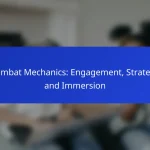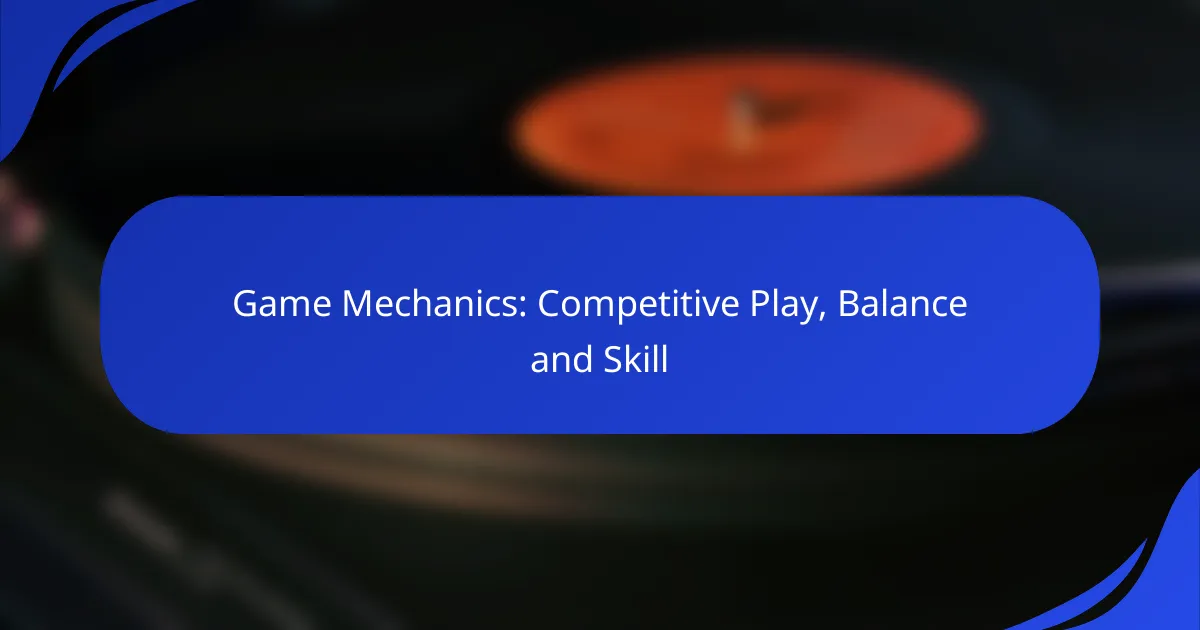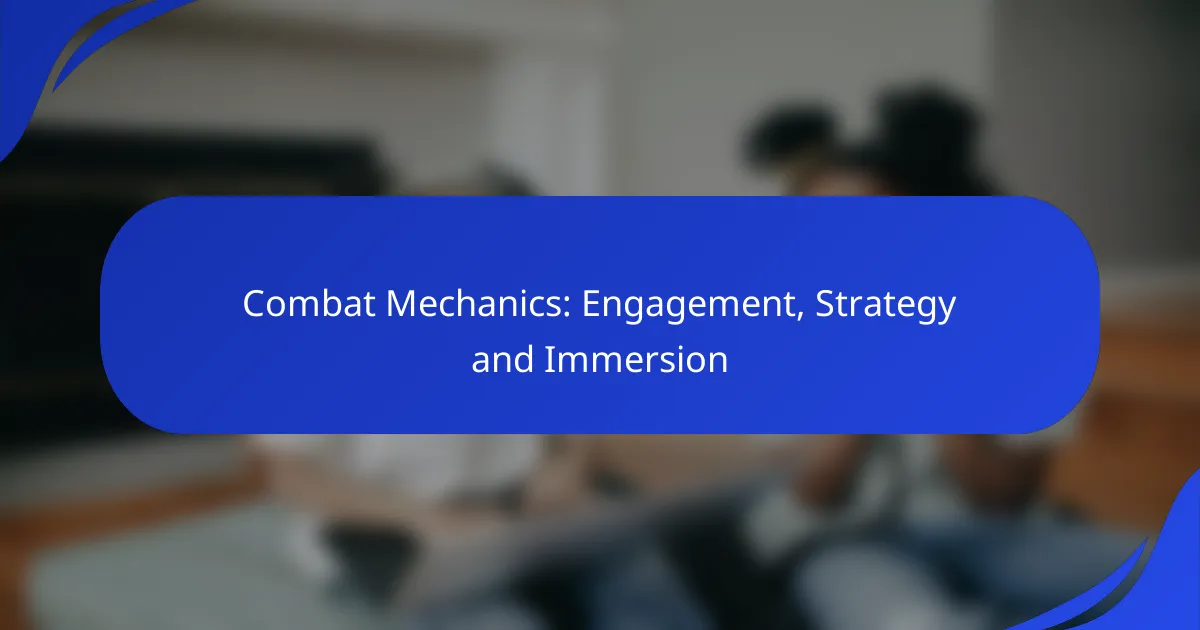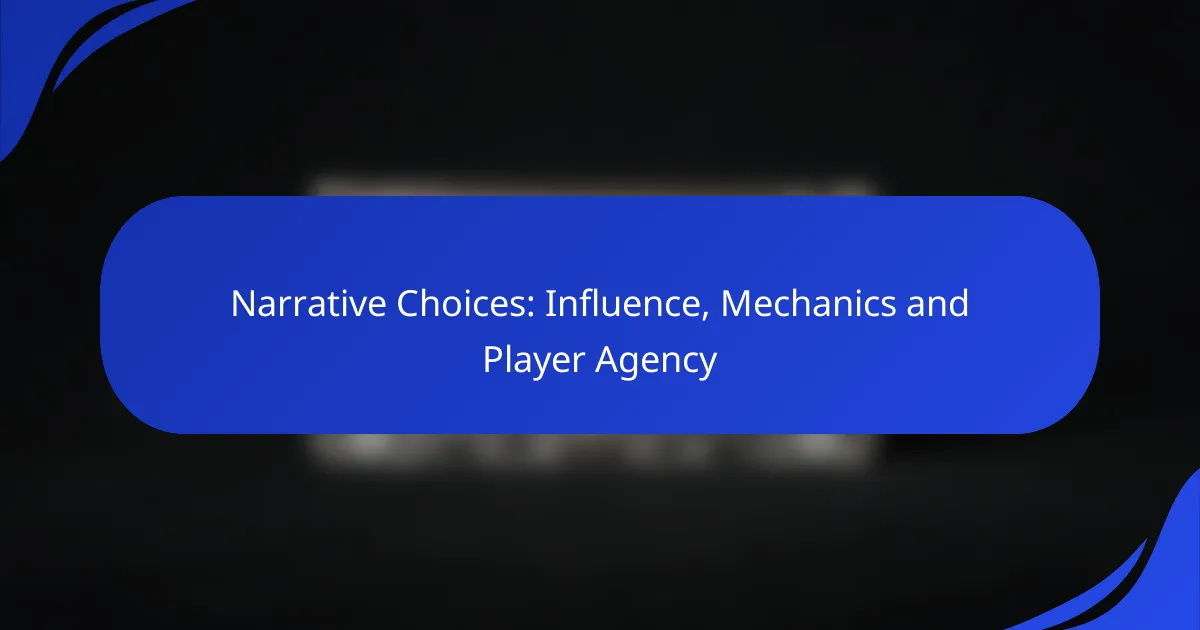In competitive gaming, effective game mechanics are essential for fostering fairness, skill expression, and strategic depth. These mechanics not only promote balanced gameplay by ensuring no single element overpowers others but also encourage players to showcase their abilities through precision and strategic thinking. Ultimately, they shape the dynamics of competition, allowing for diverse strategies and personal growth in skill.
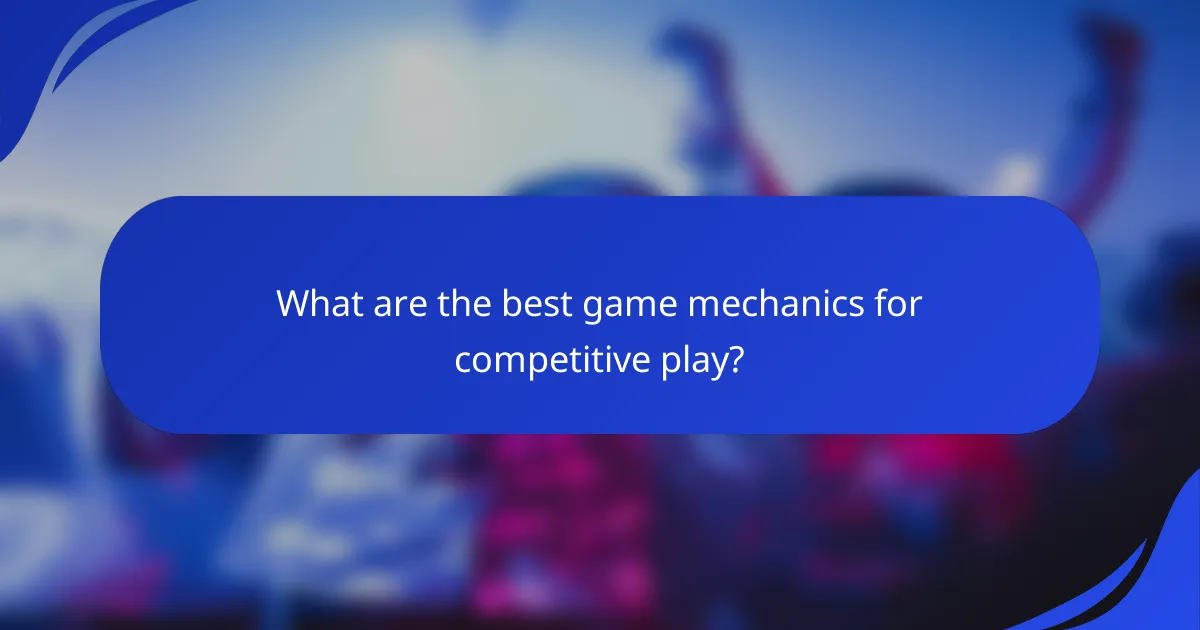
What are the best game mechanics for competitive play?
The best game mechanics for competitive play focus on fairness, skill expression, and strategic depth. These mechanics ensure that players can compete on an equal footing while allowing for varied strategies and personal skill development.
Skill-based matchmaking
Skill-based matchmaking (SBMM) pairs players of similar skill levels to enhance the competitive experience. This system evaluates player performance using metrics such as win rates and individual statistics, creating balanced matches that promote fair competition.
When implementing SBMM, consider the range of skill levels in your player base. A narrow skill gap can lead to frustrating matches, while a broader range may dilute competitive integrity. Aim for a matchmaking system that adjusts dynamically based on player performance trends.
Dynamic difficulty adjustment
Dynamic difficulty adjustment (DDA) modifies game challenges in real-time based on player performance. This mechanic keeps players engaged by ensuring that the game remains challenging without becoming overwhelming.
For effective DDA, monitor player actions and adjust difficulty levels accordingly. For instance, if a player consistently excels, increase the challenge by introducing tougher enemies or obstacles. Conversely, if a player struggles, reduce difficulty to maintain engagement and enjoyment.
Resource management systems
Resource management systems require players to allocate limited resources strategically, impacting their gameplay decisions. These systems can include currency, health, or inventory space, requiring players to think critically about their choices.
Effective resource management encourages players to weigh short-term benefits against long-term strategies. For example, in a competitive shooter, players might choose between saving ammunition for a critical moment or using it to secure an immediate advantage. Balancing these decisions is key to mastering the game.
Player progression systems
Player progression systems reward players for their efforts, enhancing engagement and motivation. These systems often include leveling up, unlocking new abilities, or gaining access to exclusive content based on performance.
To maintain balance, ensure that progression does not create significant disparities between new and veteran players. Consider implementing soft caps or diminishing returns to keep the competitive landscape fair, allowing all players to feel rewarded for their time and effort.
Team coordination mechanics
Team coordination mechanics facilitate communication and collaboration among players, essential for success in team-based games. These mechanics can include voice chat, ping systems, or shared objectives that require teamwork to achieve.
Encourage effective team coordination by designing mechanics that reward collaborative play. For example, implementing bonuses for completing objectives as a team can foster cooperation. Additionally, ensure that communication tools are intuitive and accessible to all players, enhancing the overall team experience.
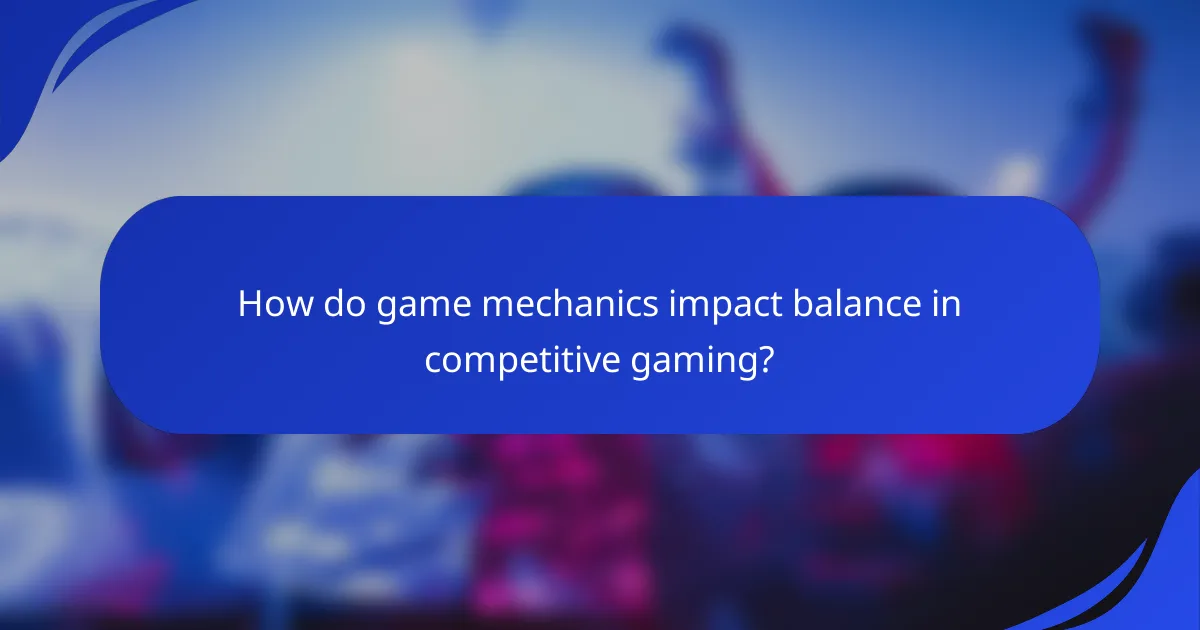
How do game mechanics impact balance in competitive gaming?
Game mechanics significantly influence balance in competitive gaming by determining how characters, abilities, and environments interact. A well-balanced game ensures that no single element dominates, allowing for diverse strategies and fair competition.
Importance of character abilities
Character abilities are crucial for maintaining balance in competitive gaming. Each character should have unique strengths and weaknesses that contribute to overall gameplay without overshadowing others. For instance, a character with high damage output may have limited mobility, creating a trade-off that encourages strategic play.
To achieve balance, developers often categorize abilities into roles such as damage dealers, tanks, and support. This categorization helps players understand their character’s function and promotes teamwork, as diverse roles can complement each other effectively.
Role of map design
Map design plays a vital role in competitive balance by influencing player movement, strategy, and engagement. A well-designed map offers varied terrain, cover options, and strategic points that can favor different play styles. For example, open areas may benefit ranged characters, while tight corridors can favor melee fighters.
Developers should consider sightlines, choke points, and spawn locations to ensure that no team has an inherent advantage. Regular playtesting can help identify imbalances and allow for adjustments before the game is released.
Effect of itemization
Itemization affects balance by providing players with tools to enhance their characters’ abilities. Items can offer buffs, healing, or unique effects that can shift the tide of battle. Balancing these items is essential to prevent any single item from becoming a must-have, which could lead to a lack of diversity in gameplay.
Developers can implement tiered item systems where higher-tier items are harder to obtain, ensuring that players must make strategic choices about their loadouts. This encourages experimentation and adaptability during matches.
Balancing patches and updates
Balancing patches and updates are necessary for maintaining competitive integrity in gaming. Developers regularly release patches to address imbalances caused by character abilities, map design, or itemization. These updates can include nerfs to overpowered elements or buffs to underperforming ones.
Players should stay informed about patch notes and adapt their strategies accordingly. Understanding the impact of these changes can provide a competitive edge, as the metagame evolves with each update. Regularly reviewing community feedback can also guide developers in making effective adjustments.
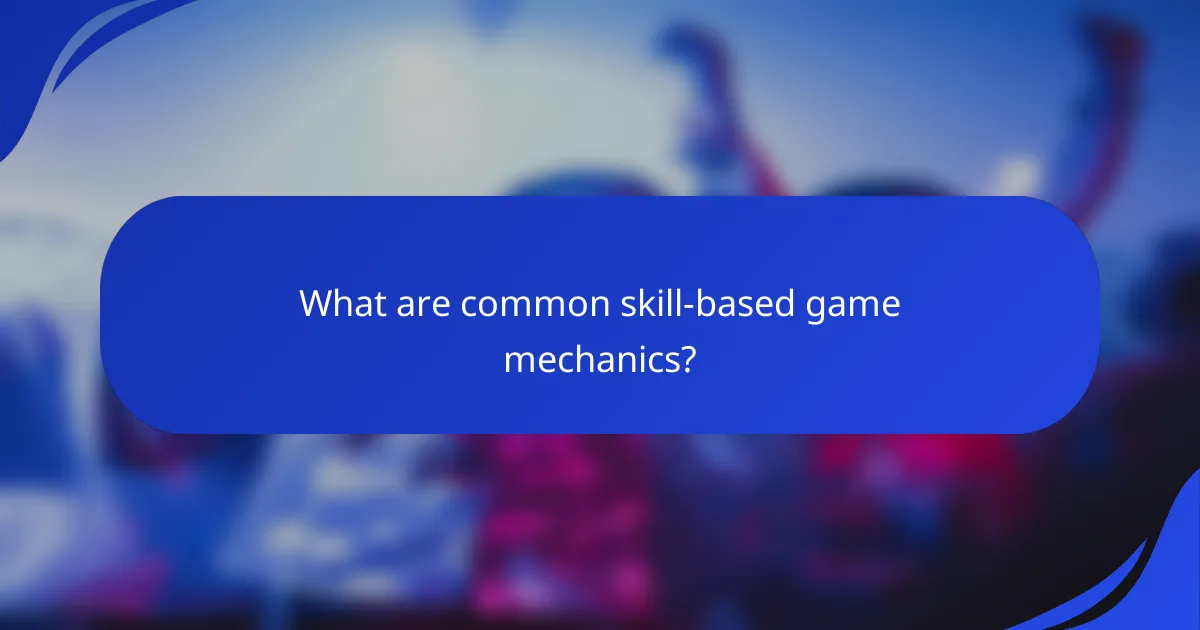
What are common skill-based game mechanics?
Common skill-based game mechanics include various elements that require players to demonstrate their abilities to succeed. These mechanics often emphasize precision, timing, and strategic thinking, significantly impacting competitive play and overall game balance.
Aim precision mechanics
Aim precision mechanics focus on the player’s ability to accurately target and hit opponents or objectives. This can involve using a mouse or controller to aim at moving targets, requiring practice to improve accuracy. Games like first-person shooters often utilize these mechanics, where players must develop muscle memory for optimal performance.
To enhance aim precision, players should practice regularly in training modes or aim trainers, which can improve hand-eye coordination and reaction times. Avoid relying solely on auto-aim features, as they can hinder skill development and diminish the competitive experience.
Timing-based skill checks
Timing-based skill checks require players to execute actions at precise moments to achieve desired outcomes. This can include executing combos in fighting games or dodging attacks in action titles. Mastering timing can lead to significant advantages in competitive scenarios.
Players should focus on understanding the rhythm of their character’s abilities and the animations of opponents. Utilizing practice modes can help players refine their timing, while observing high-level gameplay can provide insights into effective timing strategies. Avoid becoming overly reliant on visual cues; auditory signals can also be crucial for timing success.
Strategic decision-making
Strategic decision-making involves analyzing the game state and making informed choices that can lead to victory. This includes resource management, positioning, and predicting opponents’ actions. Games with complex mechanics, like real-time strategy or multiplayer online battle arenas, heavily rely on strategic thinking.
To improve strategic decision-making, players should study game maps, understand character strengths and weaknesses, and practice adapting to different scenarios. Keeping track of opponents’ movements and anticipating their strategies can provide a competitive edge. Avoid making impulsive decisions; taking a moment to analyze the situation can lead to better outcomes.

How do players achieve balance in competitive games?
Players achieve balance in competitive games by understanding game mechanics, adjusting strategies, and leveraging skills to create a fair playing field. This involves recognizing the strengths and weaknesses of various characters or strategies and adapting accordingly to maintain competitiveness.
Understanding meta-game strategies
Meta-game strategies refer to the prevailing tactics and character choices that dominate a competitive scene at any given time. Players must stay informed about these trends, as they can shift based on patches, updates, or emerging strategies. For example, if a particular character becomes overpowered due to a recent update, players may need to adjust their choices to counter this advantage.
To effectively engage with meta-game strategies, players should regularly analyze tournament results and community discussions. This can help identify which strategies are currently effective and which are falling out of favor. Keeping a flexible mindset allows players to adapt their gameplay and remain competitive.
Adapting to opponent tactics
Adapting to opponent tactics is crucial for maintaining balance in competitive play. This involves observing an opponent’s moves and strategies during a match and adjusting one’s own approach accordingly. For instance, if an opponent frequently uses aggressive tactics, a defensive strategy may be more effective to counter their approach.
Players should practice reading their opponents and predicting their next moves. This can be enhanced through experience and by studying common patterns in gameplay. Additionally, maintaining a diverse skill set allows players to switch tactics seamlessly, which can be a significant advantage in fast-paced competitive environments.
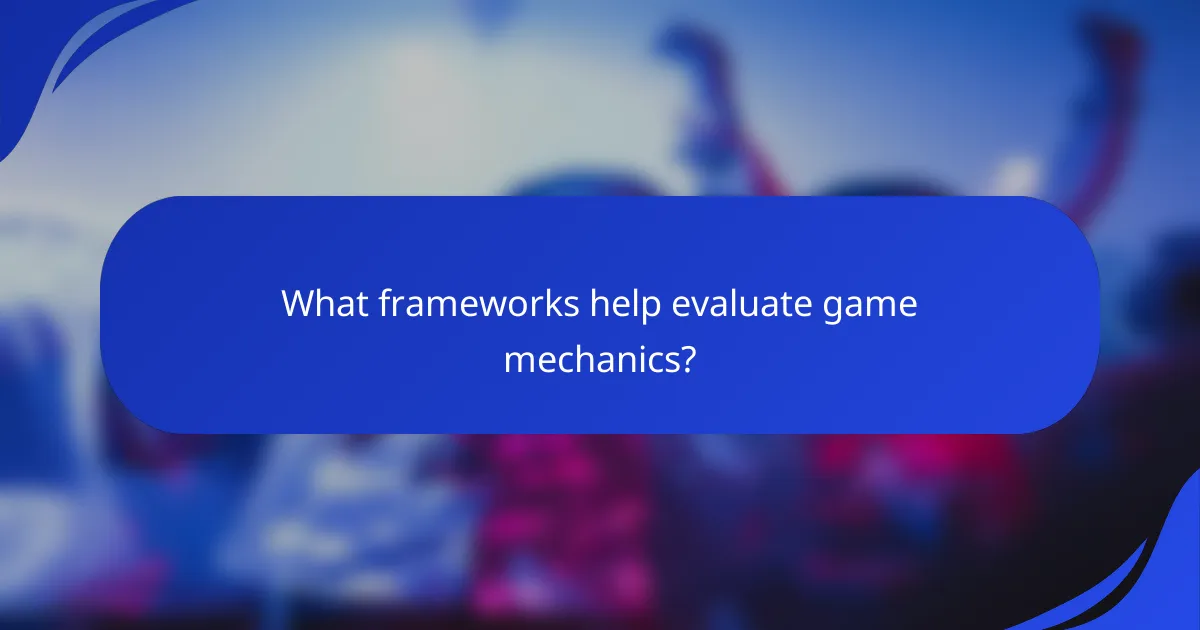
What frameworks help evaluate game mechanics?
Several frameworks assist in evaluating game mechanics, focusing on balance, competitiveness, and player engagement. These frameworks help designers understand how different elements interact and affect player experience.
Game design principles
Game design principles are foundational concepts that guide the creation of balanced and engaging mechanics. Key principles include fairness, challenge, and player agency, which ensure that players feel both challenged and in control of their experience. For example, a well-balanced game should provide equal opportunities for success, regardless of player skill level.
When applying these principles, consider the trade-offs between complexity and accessibility. A game that is too complex may alienate new players, while one that is overly simplistic may fail to engage experienced players. Striking the right balance is crucial for maintaining a competitive environment.
Player feedback loops
Player feedback loops are mechanisms that provide players with information about their performance and the game’s state, influencing their decisions and strategies. Positive feedback loops reward players for successful actions, encouraging them to repeat those actions, while negative feedback loops can help balance gameplay by penalizing poor performance.
To create effective feedback loops, ensure that players receive timely and clear feedback. For instance, visual indicators or sound effects can signal achievements or failures, enhancing player engagement. Additionally, consider the pacing of feedback; too much information at once can overwhelm players, while too little can lead to confusion.

What are emerging trends in game mechanics for competitive play?
Emerging trends in game mechanics for competitive play focus on enhancing player engagement and ensuring balanced experiences. Key developments include the integration of artificial intelligence for matchmaking, dynamic difficulty adjustments, and the incorporation of player feedback into game design.
Integration of AI for matchmaking
The integration of AI for matchmaking is revolutionizing competitive gaming by creating more balanced and fair matches. AI algorithms analyze player performance, skill levels, and play styles to pair participants effectively, reducing the chances of mismatched games.
Effective matchmaking can lead to improved player satisfaction and retention. For instance, AI can consider factors such as win rates, average game duration, and even player behavior to ensure that matches are competitive and enjoyable. This approach can significantly enhance the overall gaming experience.
However, developers should be cautious about over-reliance on AI. While it can streamline matchmaking, it’s essential to maintain human oversight to address unique player needs and preferences. Regularly updating the algorithms based on player feedback can help maintain balance and fairness in competitive play.


